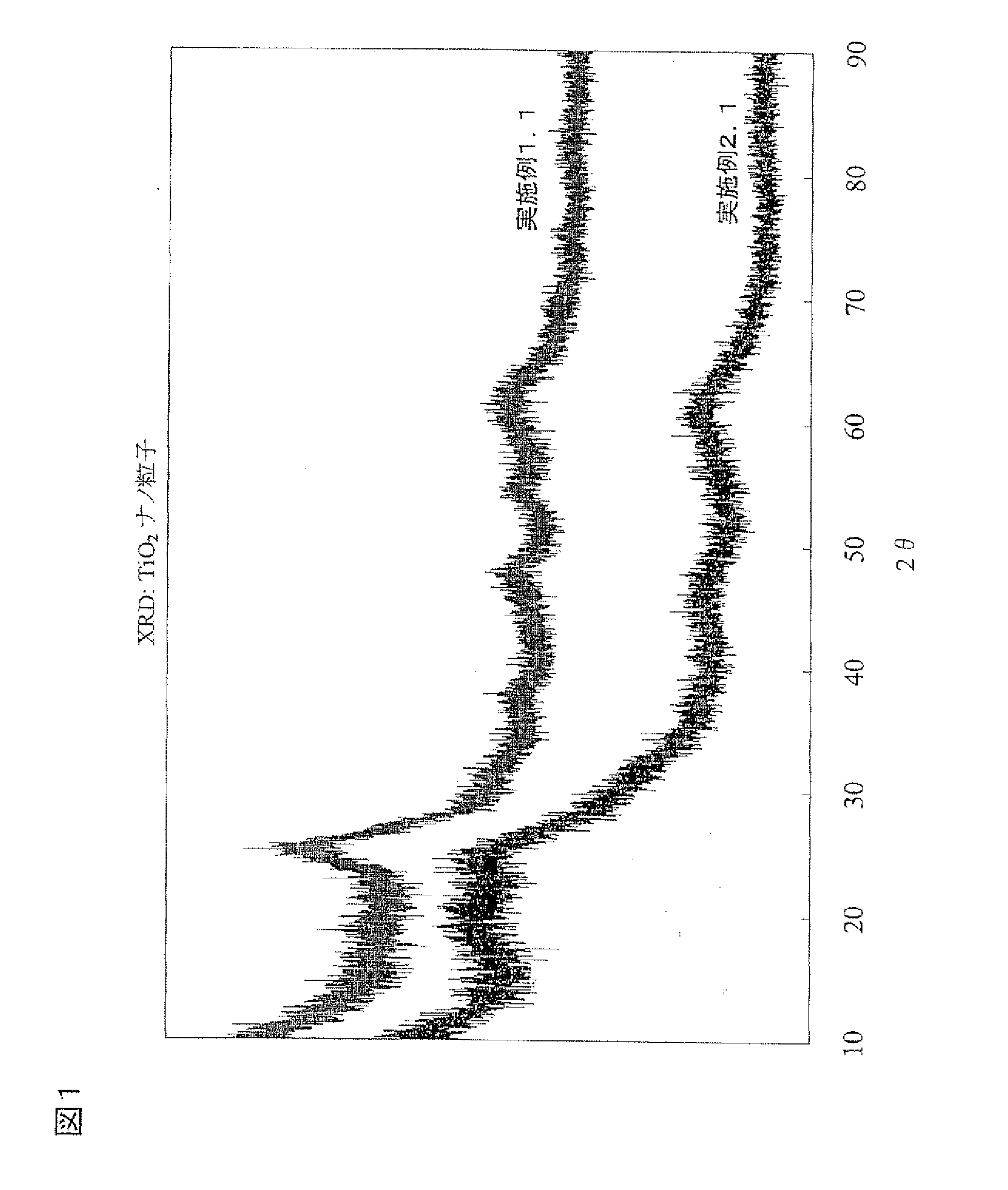Metal oxide nanoparticle, process for producing the same, nanoparticle dispersed resin and method for producing the same
a technology of metal oxide nanoparticles and nanoparticles, which is applied in the direction of cellulosic plastic layered products, natural mineral layered products, other chemical processes, etc., can solve the problems of inability to apply the above method (1), difficulty in producing transparent materials full of inorganic fine particles, etc., and achieves efficient production and high refractive index
- Summary
- Abstract
- Description
- Claims
- Application Information
AI Technical Summary
Benefits of technology
Problems solved by technology
Method used
Image
Examples
example 1.1
Synthesis of MPTS-TiO2 Nanocrystal
[0139]8.90 Grams of sodium di(2-ethylhexyl)-sulfosuccinate (ACT) (supplied by Tokyo Chemical Industry Co., Ltd.), 3.60 ml of distilled water (supplied by Wako Pure Chemical Industries, Ltd.) and 0.77 g of p-toluenesulfonic acid monohydrate (PTSH; supplied by Wako Pure Chemical Industries, Ltd.) were added to 100 ml of xylene (supplied by Kanto Chemical Co., Inc.), and the mixture was stirred until it formed a homogenous solution, to prepare a reversed micelle. To this solution was added 3.78 ml of mercaptopropyltrimethoxysilane (MPTS) (supplied by Tokyo Chemical Industry Co., Ltd.), and the mixture was stirred at room temperature for 20 hours. To this solution was dropwise added a solution of 5.68 q of titanium tetraisopropoxide (TTIP) (supplied by Aldrich) in 40 g of n-hexyl alcohol. For promoting shell generation by crystallization of TiO2 fine particles and dehydration-condensation of MPTS, further, the above solution was heated with a microwave ...
example 1.2
Synthesis of MPTS-ZrO2 Nanocrystal
[0142]2.12 Grams of ZrO2 nanocrystal having MPTS introduced on its surface was obtained in the same manner as in Example 1.1 except that TTIO was replaced with 7.67 g of zirconium tetra-n-butoxide (ZTB: supplied by Wako Pure Chemical Industries, Ltd.).
[0143]From the results of XRD and TEM, it was seen that the core contained tetragonal-system ZrO2 having an average particle diameter of 3.0 nm. In 1H-NMR spectrum, a peak corresponding to a 3 mercaptopropyl group was measured, so that it was found that a functional group derived from MPTS was introduced onto the surface of each particle. Further, the tetragonal-system ZrO2 core had a volume factor of 0.82, and the product had a refractive index of 1.96.
example 1.3
Synthesis of MPTS-TiO2 Nanocrystals Having Different Sizes
[0144]Syntheses were carried out in the same manner as in Example 1.1 except that the amounts of distilled water, PTSH, TTIP and MPTS were changed as follows.
Ex.H2O (ml)PTSH (g)TTIP (g)MPTS (ml)(2)1.80.392.841.89(3)7.21.5411.367.56(4)10.82.3117.4011.34(5)14.43.1222.715.1
[0145]
Core averageparticlediameterCore volumeRefractiveEx.Anatase(nm)factorindex(2)◯1.60.721.68(3)◯6.80.892.28(4)◯10.90.942.38(5)◯15.80.982.48
PUM
| Property | Measurement | Unit |
|---|---|---|
| molar ratio | aaaaa | aaaaa |
| particle diameter | aaaaa | aaaaa |
| size | aaaaa | aaaaa |
Abstract
Description
Claims
Application Information
 Login to View More
Login to View More - R&D
- Intellectual Property
- Life Sciences
- Materials
- Tech Scout
- Unparalleled Data Quality
- Higher Quality Content
- 60% Fewer Hallucinations
Browse by: Latest US Patents, China's latest patents, Technical Efficacy Thesaurus, Application Domain, Technology Topic, Popular Technical Reports.
© 2025 PatSnap. All rights reserved.Legal|Privacy policy|Modern Slavery Act Transparency Statement|Sitemap|About US| Contact US: help@patsnap.com

